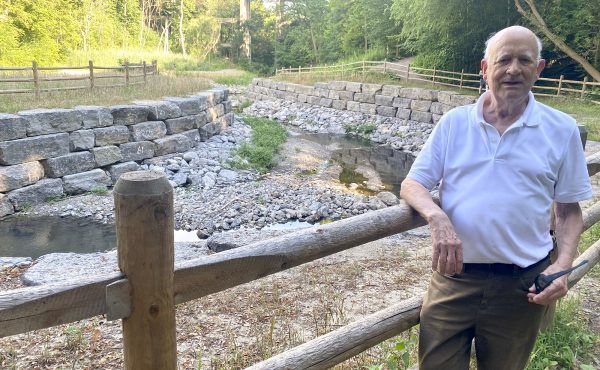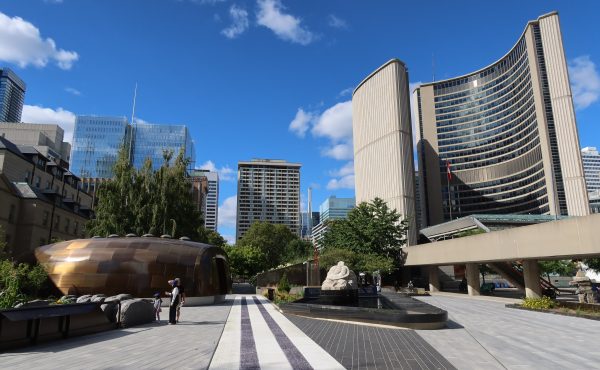
IOWA CITY, IOWA — The last city I stopped to see on my trip, before gunning the car to get home to Toronto, was the university town of Iowa City in the southeastern part of the state of Iowa. It only has 60,000 residents, but since its populated with thousands upon thousands of students (a third of the city’s population) from all around the country, its doesn’t fit into the small-town Midwest stereotype.
Iowa City is home to the University of Iowa which plays a central role in the town. It sits just to the east of the downtown core. Since Iowa City was once the capital of the state, it has a large capitol building that has been surrounded by the campus. So its no surprise to see that the downtown caters to the culture of student life. There are numerous poster kiosks, lots of cafés, and a pedestrian mall that is about five square blocks.
While the downtown does a nice job with its streetscape, keeping it super clean while playing on its colonial roots, I was slightly surprised by the existence of some excellent graffiti and poster art. The following are some photos of the city’s streets and laneways.

The pedestrian mall was a little dead since a constant drizzle hung over the town while I was there. The most frequent peice of street furniture I found were benches. Benches, benches, benches. Iowa City seems to hav e asimilar climate to Toronto, so the trees were just starting to bud. Here’s a link to what it looks like in full bloom.

I really dug the covered seating area — makes for a good place to hide out when the rain hits or the sun is too intense.

Info pillars that show the campus and downtown area.

Another info pillar that highlights community news, distributes newspapers, and provides a local map.

A poster kiosk.

As you can see, the poster kiosk, as well as the info pillars, mimick the city’s capitol building. It’s a nice touch to see a local design element reflected in the street furniture — its gives the city a unqiue feel at street level.

This street-side ashtray was something I hadn’t seen before. At first I thought it was a bike rack.


Bike racks were everywhere in town, and even the parking meters were equipped with racks.

I really liked the neighbourhood markers on the street signs. The above image is for the Husi Mesto area. I saw about five different markers with different designs.


Back on the pedestrian mall, I found a few bronze sculptures that wrre related to specific events and places in Iowa City.


Embedded in the sidewalks were numerous designs referencing different forms of literature produced by famous Iowan writers.


In the laneways that abutted the pedestrian mall I found numerous stencil graffiti. It was nice to see the the rougher edges of the city hiding behind the the prim-and-proper feel of the downtown.


There also seemed to be a poster artist who liked placing his face in the middle of iconic imagery.

This newsbox was empty of any contents, but again it was nice to see a dose of intervention art beside the fully sanctioned street furniture.



10 comments
Hey, I told you college towns were the way to go;-)
Interesting with that graffiti guy doing “American Gothic”, considering that this is Grant Wood country…
What is eye opening about this series, from a smug Torontonian’s perspective, is how well the smaller US cities visited during this trip have grasped the notion of an effective pedestrian environment. However, it may be unfair to compare a small town with a Metropolis and we’ll have to see how the street furniture program fares.
Bob> It’s true, most US towns and cities I go to on my own tours have nice little Projects for Public Space style downtowns (federal money flows for this kind of thing in America, we hear) but you get outside of it, an it’s a lot of White Castle from there on in. Which is not meant to be smug, but only to temper “look how much Toronto sucks compared to Chicago’s Millennium Park” or some such.
Toronto, and Canada in general, spreads the “good” around more. The downtown good might be less intense, but it extends further afield.
That said, so many lessons about street furniture not-for-sale indeed.
This was a great series. Hope you make it an annual event.
American college towns ARE the way to go. I’m typing this from a computer lab at ASU in Tempe, Arizona and lemmetellya, this little town basically redeems the vacuity that is Phoenix.
In Windsor we’d make at-least monthly treks to Ann Arbor for that college town stuff. Book stores, cafe’s, etc. But after a while it becomes some kind of stepford-collegiate — and boring (but pretty). Much rather have big city university’s like U of T or Columbia or NYU, where the collegiate mixes with the civic.
Hey Matt,
Glad you took my advice and went through Iowa, or maybe you went despite my advice 🙂
Cheers.
Nice pictures you took of our community. Glad you liked it enough to share with your viewers. Stop back again at different times of the year to see how it changes from season to season. There are many other things you could have mentioned such as the number of busses you can watch that move in and out of downtown and campus. Iowa City and environs have 3 mass transit systems, one in Iowa City, one in Coralville, and one for the University of Iowa campus. I drive one of them.
I should note, my “boring” comment above is IMHO, due to liking big cities over small towns — so that part is unfair. Though there is a certain monoculture I find in Uni towns. Still, they do feel comfortable.
I remember Jesse Helms once said they should put at fence around Chapel Hill and call it a Zoo, as these kinds of places are such bastions of liberalism.
I can identify the poster artist. the American Gothic and the Andy Warhol soup can were done by Scott Ulrich.
He has been doing art all over the city there for a few months now. I was excited to see someone taking pictures of his work. I have two paintings he has done on canvas.